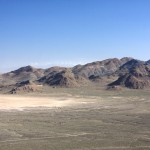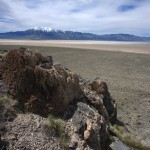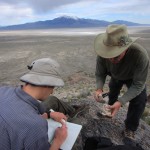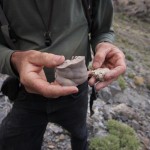A ghost lake
Scientists study an ancient lake that once covered much of Utah to learn lessons for the future
By Douglas Fox

The deserts of northwest Utah are wide and flat and dusty. As our car zooms along Highway 80, we see only a few green plants — and one of those is a plastic Christmas tree that someone stood up by the road as a joke.
This may sound like a boring ride, but I can’t help but stare out the car window. Every time we pass a mountain, I notice a line running across its side. The line is perfectly level, as if someone carefully drew it with a pencil and a ruler.
For two hours driving west from Salt Lake City toward the Nevada-Utah border, the line runs across several mountain chains, including the Wasatch and the Oquirrh (pronounced “oak-er”). It is always a few hundred feet above the ground.
The driver of our car, David McGee, is a scientist who is super-interested in that line. He looks at it probably more than he should. “It’s always dangerous having a geologist drive,” he admits, as he glances back at the road and nudges the steering wheel to keep our car on course.
Most natural landscapes are curvy, bumpy, jagged — all kinds of shapes. When you see something straight, people usually built it that way for a purpose, like a train track or highway. But this line across the mountainsides formed naturally.
It was carved into the mountains by Lake Bonneville, an ancient, inland body of water that once covered much of Utah — one about the size of Lake Michigan today.
Wetter past, drier future?

It’s hard to believe that a lake once covered this dusty desert. But during the end of the last Ice Age — between 30,000 and 10,000 years ago, when woolly mammoths roamed across North America and humans hadn’t yet arrived on the continent — enough snow and rain fell to keep Bonneville brimming with water. Never mind the prickly plants growing here today; the lake back then was 900 feet deep in some places!
Over thousands of years, as the climate got wetter, Lake Bonneville’s water level climbed up the mountainsides. Later, as the climate got drier, the water level fell. The shoreline that we see from the car is the most obvious one (the water level stayed there for 2,000 years). But the lake also eroded other, fainter shorelines whenever it sat somewhere for a few hundred years. “You can often see many, many shorelines,” says McGee, who works at the Massachusetts Institute of Technology, “especially with aerial photographs.”
McGee has looked at many aerial photos of this place. He and another geologist, Jay Quade of the University of Arizona in Tucson, want to know more about Lake Bonneville’s ups and downs.
“It really looks like many of the deserts of the world were much wetter” during the Ice Age, says Quade. “That’s led some of us to think about the future of deserts. As climate warms, what’s going to happen to rainfall?”
It’s an important question. Earth’s temperature is slowly rising because of increased levels of carbon dioxide and other gases in the atmosphere. These gases trap heat, contributing to global warming through a phenomenon known as the greenhouse effect. Carbon dioxide is produced from the burning of fossil fuels like oil, gas and coal. Other greenhouse gases are produced by human activity, too.
Some scientists predict that as temperatures warm, the western United States will become drier. The question is how much drier. “That’s the idea we want to test,” says Quade, who is leading the study of Lake Bonneville’s dry remains.
Even a small decrease in rain could have dire effects in areas of the United States that are already dry. If your great-grandparent is still alive, for example, then maybe he or she has told you about the great Dust Bowl drought of the 1930s. It devastated farms from New Mexico to Nebraska and forced tens of thousands of people to leave their homes. And yet the amount of rain that fell in these areas during the drought was only 10 to 30 percent less than usual!
Quade and McGee want to know whether warming climates could make this kind of dryness commonplace in the next 100 years. They are studying Lake Bonneville to answer that question. By building a detailed history of the lake’s ups and downs, Quade and McGee hope to figure out how rain and snowfall changed as the climate became warmer during the end of the Ice Age, about 30,000 to 10,000 years ago. If they can understand how temperatures affected rainfall, then it will help scientists better predict how rainfall will change with Earth’s rising temperatures.
Silver Island
Two days after our long drive across northwestern Utah, I finally get to see one of those ancient shorelines up close. On a cloudy morning, I climb with McGee, Quade and two other scientists up the slopes of a small mountain chain called the Silver Island Range. These mountains are fittingly named, since Lake Bonneville used to surround them!

After 15 minutes of slipping on steep gravel — not to mention walking carefully around two rattlesnakes that weren’t happy to see us — the slope of the mountain suddenly levels out. We’ve reached the shoreline that we saw from the highway. It is flat, like a dirt road winding along the mountainside. There are other signs, too, that most of this desert was once under water.
The mountain is made of gray stone, but here and there the gray boulders are covered in crusts of light-brown rock. The knobby, curvy, light-colored crust looks like it doesn’t belong here. It looks as if it used to be alive, like the hard skeletons of coral that once grew on a sunken ship. This isn’t too far from the truth.
This light-colored crust was laid down thousands of years ago by algae. These are single-celled organisms very similar to plants. The algae grew in thick carpets on underwater rocks. It grew where the water was shallow, because — like plants — algae need sunlight.
Bathtub rings
The lake left behind other clues, in darker nooks and crannies where algae couldn’t grow — like the insides of caves or underneath big piles of gravel. In these places, minerals in the water gradually solidified into other kinds of rock that coated everything else. You might say that the lake was laying down bathtub rings.
Have you noticed the grimy rings that grow around the sides of a bathtub when it isn’t scrubbed for a long time? Those rings form as minerals in the bathwater stick to the sides of the tub.
The same thing happened here at Bonneville: Minerals from the lake water gradually coated the rocks and pebbles under water. The dirty rings on your bathtub are thinner than paper, but the mineral coating that Lake Bonneville left behind was up to 3 inches thick in some places — a warning of what might happen if you didn’t scrub your tub for 1,000 years!
After the lake dried up, wind and rain peeled most of that coating off of the rocks, although a few pieces remain. Just now I stoop down to pick one of them up.
The rock is rounded on one side, like a golf ball that’s been broken in half. It is made of layer upon layer of a brown mineral called calcite — the bathtub rings. Another mineral, called aragonite, forms a frosty white coating on the outside. At the center is a tiny snail shell. The minerals probably started forming on the shell and from there grew outward over centuries.
“It probably got washed down from wherever the shoreline was,” says Quade, nodding toward a heap of gravel a few meters above us piled up by waves long ago. The minerals would have grown around the snail shell somewhere deep in the pile, hidden from sunlight. “This was probably 23,000 years ago,” says McGee.
Quade takes a closer look at my pretty rock. “Do you mind?” he asks. He takes it from my hand, writes a number on it with a black marker, and drops it into his sample bag.
Back at the lab, Quade and McGee will grind away part of the snail shell. They’ll analyze the carbon in the shell to see how long ago the snail lived and when the minerals grew around it. They’ll saw through the layers of mineral coating the shell and read them like tree rings. They can analyze the carbon, oxygen, calcium and magnesium in each layer to see how the saltiness of the lake varied over the hundreds of years that the minerals grew. This will help the scientists estimate how quickly water poured into the lake and then evaporated into the sky.
All of this will give them an idea of how much rain and snow was falling as the lake grew and shrank. If Quade and McGee can collect enough of these rocks, they can piece together a more detailed version of the lake’s history between about 30,000 and 15,000 years ago, when the lake was in its heyday.
Mystery layer
Quade and McGee aren’t the only people studying Lake Bonneville. Jack Oviatt, a geologist from Kansas State University in Manhattan, is looking for clues to a later part of the lake’s history, when it was smaller and shallower. Eighty-five miles southeast of the Silver Island Range, a barren desert plain stretches between three mountain chains. For 65 years, the U.S. Air Force has used this area as a training ground; pilots fly practice missions overhead.
Very few people are allowed to set foot here. Oviatt is one of the lucky few.
“Because it’s been off-limits to everybody except the military, pretty much everything is left in place,” he says. “You can walk for miles out there and find artifacts that haven’t been touched for 10,000 years.” He sometimes spots stone cutting tools left behind by some of the first humans to arrive in North America.
Dig into the dry crust that covers the ground here — as Oviatt has done — and a couple of feet down, your shovel turns up another strange discovery: a thin, gritty layer of earth as black as coal.
Oviatt has brought many bags of that black stuff back to his lab, where he and his students spend hours looking at it under a microscope. A slide of the black stuff reveals thousands of pieces, none much bigger than a grain of sand. Once in a while Oviatt spots a piece that he recognizes: It looks like a plant fragment. Tiny veins run through it, like those in a leaf or stem. He grasps it with tweezers and sets it in a little pile to the side of the microscope.
That plant piece belongs to an old cattail reed that might have stood 6 feet tall in a marsh where the dusty plain now is. The black grit is all that remains of the marsh, which was home to many other living things. Oviatt sometimes finds the bones and shells of fish and snails that once lived there, too.

Bonneville had nearly evaporated by the time the marsh formed, but a smaller lake to the south, called Sevier Lake, was still wet. Because Sevier sat at a higher elevation, its water constantly spilled into Lake Bonneville. That water formed a thriving marsh in one little corner of Bonneville’s otherwise dry bed.
Thousands of years of rotting, drying and burial squished the once-lush oasis of life into an inch-thick layer of black stuff. Oviatt uses the well-preserved bits of water plants that he finds to figure out exactly when this marsh brimmed with life. Using the same method that McGee and Quade use to date snail shells, Oviatt can tell how long ago the plants lived.
So far, the marshy bits seem to be 11,000 to 12,500 years old — they grew not long after humans first arrived in the area.
Oviatt has spent 30 years studying Lake Bonneville’s remnants. But he and the other scientists still have plenty more work to do.
“I like going out in the desert and seeing these things,” says Oviatt. “It’s just a fascinating place. It’s like a gigantic puzzle.”
The dead marsh, the shorelines carved into the mountainsides and the mineral bathtub rings are only a few of the many clues left behind by Lake Bonneville. If Oviatt, Quade, McGee and others can put these pieces together, scientists will have a better understanding of how rain and snowfall have changed in the western United States over thousands of years. And that information will help scientists predict just how much drier the West may become in the future.
POWER WORDS
Algae Single-celled organisms — once considered plants — that grow in water.
Calcium An element present in large amounts in bone, teeth and stones such as limestone. It can dissolve in water or settle out to form minerals such as calcite.
Carbon An element present in bones and shells, as well as in limestone and minerals such as calcite and aragonite.
Erode To gradually wear away stone or soil, as water and wind do.
Evaporate To gradually turn from a liquid into a gas, as water does if it is left sitting in a glass or bowl for a long period of time.
Geologist A scientist who studies the history and structure of Earth by looking at its rocks and minerals.
Ice Age A period of time when large parts of North America, Europe and Asia were covered by thick sheets of ice. The most recent ice age ended around 10,000 years ago.
Magnesium An element that can dissolve in water and is present in small amounts in some minerals, such as calcite and aragonite.
Organsim Any living thing, including plants, animals, fungi and single-celled life forms such as algae and bacteria.
Oxygen A gaseous element that makes up about 20 percent of Earth’s atmosphere. It is also present in limestone and in minerals such as calcite.
Tree rings Rings visible if the trunk of a tree is cut through with a saw. Each ring forms during a year of growth; one ring is equivalent to one year. Thick rings form in years that were wet, when the tree was able to grow a large amount; thin rings form in dry years, when tree growth slows.







